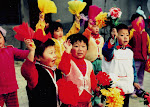CNN had an article listing the 10 best farmers markets in the United States that are good for travelers. I was surprised to see that Seattle's Pike Place Market, a major tourist attraction in the Emerald City, wasn't on the list, though a smaller Seattle area farmers market was.
I used to love to go to farmers markets, seeing the produce all fresh and gleaming. But that was before I moved to Beijing. If you wanted fresh fruit and vegetables, you bought from a produce stand on the street: tomatoes at one stand, celery and carrots at another, apples here, bananas there. At each stand, because you were a foreigner, you had to bargain hard to get a price that was anywhere close to what the Chinese paid. Produce shopping was no longer fun; instead, it became a dreaded chore.
The picture is a veggie stand in Chaping, a suburb of Beijing, where we visited friends on our last trip to China. Most veggie stands don't have this variety of produce. Here's a link to an article I wrote about the vegetables you can find in China.
I occasionally go to our local farmers markets, but I don't enjoy them as much. Once in awhile, we might go to the Pike Place Market, but mainly because my husband likes a couple of magazine shops there.





